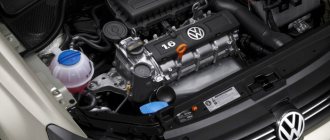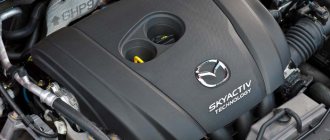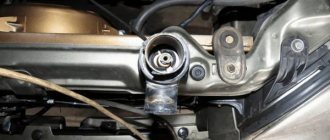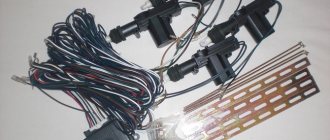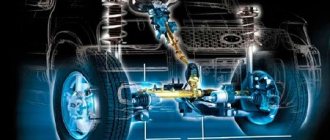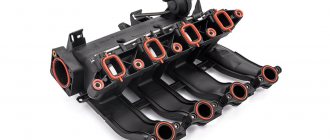The Ulyanovsk Motor Plant began producing high-power engines in 1997; the first internal combustion engine with a cylinder diameter of 100 mm was the carburetor UMZ 4215, and in 1998 the Ulyanovsk team developed a new injection engine with a capacity of 110 hp. pp., corresponding to Euro-2 standards. UMZ 4216 gasoline engines began to be produced in pilot batches in 2003, and they were soon put into production.
Model 4216 is installed on GAZ vehicles; Gazelle commercial vehicles are equipped with this power unit. In 2008, the Ulyanovsk engine was improved, and it began to comply with Euro 3 standards, and since 2012 it has been brought to the Euro 4 standard. In 2013, hydraulic compensators began to be used on this engine, and since 2014, the Ulyanovsk plant began assembling EvoTech motors volume of 2.7 liters, which is installed on commercial vehicles “Gazelle Business” and “Gazelle Next”.
Engine structure UMZ 4216
The prototype of the Ulyanovsk Motor Plant engine is the ZMZ-21 engine - it has a fundamentally the same design:
- aluminum cylinder block;
- top valve arrangement;
- gear drive of the gas distribution mechanism;
- aluminum rods;
- lower camshaft location;
- two valves per cylinder.
Even the oil sump has a similar configuration - it is also steel, stamped, with recesses at the front and rear.
Just like on the ZMZ-21, on the Ulyanovsk engine the pistons and connecting rods are connected using “floating” piston pins - the pistons are seated “cold”, copper (bronze) bushings are pressed into the upper bushings of the connecting rods.
On all UMZ engines with a cylinder diameter of 92 mm, “wet” removable liners are installed in the cylinder block (BC). In a block with a piston diameter of 100 mm (models UMZ 4215, 4213 and 4216), the liners are pressed using special equipment, and during repairs they cannot be pressed out, therefore, if the cylinders are significantly worn, the BC must be replaced.
Engine 4216 consists of the following parts:
- an aluminum cylinder block into which four cast iron liners are pressed;
- block heads made of aluminum (4 combustion chambers, each with 2 valves), a rocker axis is attached to the top of the cylinder head;
- crankshaft with main (5 bearings) and connecting rod journals (4 journals);
- single-mass flywheel with ring gear;
- pistons with piston pins and rings, each piston has two compression rings and one oil scraper ring;
- connecting rods;
- oil pump;
- rods and pushers;
- main and connecting rod bearings;
- oil seals, gaskets;
- crankshaft hubs and pulleys;
- metal crankshaft gear and textolite camshaft gear.
The gas distribution mechanism (camshaft) is driven by the crankshaft through a pair of gears. The camshaft cams, through pushers and rods, raise and lower the rocker arms, which in turn press the intake and exhaust valves. Due to the valves, the cylinders are filled with the air-fuel mixture, and the engine cycle occurs.
On the Gazelle Business car, the UMZ 4216 engine is equipped with an electronic control system, which includes:
- MIKAS control unit;
- ignition module;
- high-voltage wires with lugs;
- sensors - throttle valve, c/shaft and r/shaft, absolute pressure, detonation;
- wiring;
- idle air control;
- fuel injectors.
How does an injection engine work?
The operating principle of an injection engine is to supply fuel through injectors controlled by an electronic control unit (ECU). The controller monitors the state parameters of the power plant, calculates the need for supply and quantity of fuel, and provides adjustments to the fuel supply using the pulse duration.
The ECU is able to evaluate the results of calculations and commands, as well as remember previously performed manipulations, coordinating further actions with it. The process of intellectual development of the unit occurs continuously and lasts throughout the entire period of operation of the car. Fuel supply in the Gazelle-405 car (engine injector) can be carried out in two ways:
- Synchronous version - with a fixed crankshaft position.
- Asynchronous feed - independent of crankshaft rotation.
The first method is preferable. Asynchronously, fuel is usually supplied when the power unit starts. The injectors are operated in pairs or alternately.
Technical characteristics of the UMZ 4216 engine
Engine 4216 is a four-stroke, in-line four-cylinder, 8-valve. The internal combustion engine is designed to run on AI-92 gasoline; the use of higher quality fuel, for example, AI-95 gasoline, is allowed. The technical characteristics of the engine modification UMZ-42164 (Euro-4) are as follows:
- volume – 2890 cm³;
- diameter of standard pistons – 100 mm;
- compression ratio (compression in cylinders) – 9.2;
- piston stroke – 92 mm;
- power – 107 l. With.;
- The engine cooling system is liquid (filled with antifreeze or antifreeze).
The block and cylinder head are cast from aluminum alloy. The engine of the first complete set weighs 177 kg, the engine package includes the power unit itself, and it is also equipped with attachments:
- starter;
- generator;
- intake manifold (receiver);
- ignition module with wires and tips;
- drive belts;
- water pump;
- crankshaft pulley;
- clutch basket and disc;
- ECM sensors.
According to factory standards, the fuel consumption of the Gazelle with the Ulyanovsk internal combustion engine is 10 l/100 km on the highway outside the city, in mixed mode it is 11 l/100 km. In practice, more gasoline is usually consumed, a lot depends on:
- depending on vehicle load;
- speed limit;
- period of operation (in winter, more fuel is consumed to heat up).
The UMZ 42164-80 modification engine is equipped with hydraulic compensators; this engine is equipped with Sobol Business and Gazelle Business commercial vehicles. Model 42164-80 differs little from the standard motor 4216 - this engine has other, special stays, in the upper part of which the compensators themselves are attached.
Crankshaft 4216 consists of four connecting rod journals and five main connecting rod journals, and has the following diameters:
- molar necks – 64 mm;
- connecting rod journals – 58 mm.
All journals are equipped with two steel-babbit liners; the factory tolerance for crankshaft dimensions is 0.013 mm. During the repair of a Ulyanovsk engine, the main and connecting rod journals are measured with a micrometer - if they are worn more than 0.05 mm, the shaft must be ground. The diameter of the piston pins is 25 mm, the pins are installed in bronze bushings of the connecting rods. Over time, both the pins themselves and the bushings may wear out; if play appears in the connection, the parts must be replaced.
The crankshaft in the cylinder block is mounted on supports with covers that are tightened with bolts with a certain force. Each cover has its own place - they cannot be mixed up, especially not picked up from another BC. Also, the covers must be secured to the lock - if they are installed incorrectly, the crankshaft may not turn (it will get jammed), and even if the shaft does turn, the engine will quickly fail.
Powertrain capabilities
Owners of the Gazelle-405 car are impressed by the fuel-injector engine, especially in terms of fuel consumption. It ranges from 8 liters on the highway to 13 in the combined cycle when driving around the city. Oil is also used sparingly: approximately 100 grams per thousand kilometers. In a single-point system, the manifold is equipped with only one injector for all cylinders. In a distributed block, each of them has its own collector. And with direct injection, fuel is supplied directly to the cylinders, just like a diesel engine.
Injection cars are more economical, as precise dosing occurs. In addition, the environmental friendliness of the exhaust gases released into the environment complies with the Euro 3 standard, and the power indicator increases by 10%.
This power unit is adapted to domestic climatic conditions. It tolerates heat, extreme cold and sudden temperature fluctuations well. The power plant functions clearly and reliably in the most severe and difficult climatic zones. It starts without problems in severe frost.
UMZ 4216 engine malfunctions
The service life of the 4216 engine, declared by the manufacturer, is 250 thousand km, but often the engines fail ahead of schedule. Frequently occurring internal combustion engine problems:
- engine oil leakage;
- increased oil loss through the piston rings:
- valve knocking, which is sometimes difficult to eliminate;
- overheat;
- failure of various sensors.
Various breakdowns can occur prematurely for various reasons:
- the driver violates operating conditions - the motor overheats due to overload;
- maintenance standards are not followed;
- The vehicle is operated in difficult road conditions.
Unfortunately, defects often occur in UMP engines, but ZMZ engines are not immune from this. If the 4216 engine jerks (jerks), the cause of the malfunction may be either the engine itself or a breakdown in the ECM. To determine the cause of the defect, it is necessary to diagnose the internal combustion engine.
Reviews from car owners
There are the most controversial reviews about the UMZ 4216 engine - some Gazelle owners praise UAZ engines and believe that they:
- have good traction;
- consume fuel moderately;
- inexpensive, and easy to repair.
Indeed, the UMZ 4216 engine is very simple, especially since it has significant similarities with the ZMZ-402 internal combustion engine. The design of the power unit is familiar to many drivers, and such an engine can be repaired almost in the field. Some difficulty for car owners is the electronic equipment of the engine - after all, the injector is somewhat more complex than a carburetor device.
You can also hear extremely negative responses from owners of Gazelles with UAZ engines:
- the engine is prone to overheating;
- Sensors often fail, so the engine starts to stall and not move;
- The engine consumes oil, it leaks from wherever possible.
Unfortunately, a lot of defective products come from the Ulyanovsk plant, and mostly those drivers who have received a defective internal combustion engine complain about the Ulyanovsk engine. There are several characteristic ones that are quite common on UMP 4216:
- the intake manifold cracks and begins to suck in air;
- the pump does not provide the required oil pressure;
- the electromagnetic cooling clutch refuses to work, and the motor begins to overheat.
Drivers of such unsuccessful Gazelles note that the engine often has to be “modified with a file.” It has also been noticed that if the engine is completely rebuilt with your own hands, breakdowns occur much less frequently, the main thing is to assemble the engine using original good quality parts.
UMZ 4216 engine repair
During operation of a Gazelle with a UMZ 4216 engine, various breakdowns occur, one of the most common problems being overheating of the engine. If the cooling system “airs”, antifreeze (antifreeze) begins to be thrown out of the expansion tank. As a result of overheating, the head gasket often breaks through - changing the head gasket is generally not difficult, and drivers often carry out such repairs on their own.
But the problem in case of overheating is different - often the high temperature causes the partitions on the pistons to burst and the piston rings to become stuck. To replace pistons or rings, it is not necessary to remove the engine; you just need to remove the cylinder head and oil pan.
Overhaul of UMZ 4216 is necessary in cases where:
- cylinder liners are worn or damaged;
- the crankshaft knocks (wears out);
- low oil pressure in the system, and replacing the oil pump does not give positive results.
Often the Ulyanovsk engine overheats, and drivers take various measures to get rid of this unpleasant and dangerous phenomenon for the internal combustion engine. Many Gazelle owners install a copper three-row cooling radiator instead of the standard aluminum one - copper cools antifreeze more effectively. Another method of combating overheating is to install an electric cooling fan with a toggle switch, which is located in the driver’s cab. At the moment when the sensor arrow on the instrument panel begins to show the critical coolant temperature, the driver forcibly turns on the fan, and the temperature returns to normal.
Checking with a pressure gauge
It is also possible to check the performance with a pressure gauge. This method is also quite accurate if you check the fuel pump correctly. We will need a special pressure gauge to measure the pressure in the fuel network of the GAZelle 405 injector. You can do all the operations yourself; you don’t need the help of specialists. The instructions for such a pressure gauge say that it must be connected to the injector rail and secured so that the pressure gauge readings can be seen from the passenger compartment. When the driver turns on the ignition, the pressure gauge starts working and takes readings of the pressure created by the fuel pump. The norm for pressure fluctuations in the fuel system of the GAZelle 405 injector is from 300 to 380 kPa (kilo Pascal). After this, you need to drive along such a section of the road that at least third gear is engaged and then measure again. If the pressure gauge readings have not changed, then there is no need to worry about anything yet, and something else needs to be repaired, not the fuel pump.
If there are significant changes in the readings, you will have to contact a GAZelle 405 injector repair specialist.
If the car starts to stall while driving, then the problem lies in the electrical component. You can check if this is why the fuel pump is not working correctly by performing a test of the fuel pump relay. To do this, we need a regular control lamp, and the test itself looks like this: when the lamp is connected to the yardarm and the ignition is turned on, the lamp should light up for a few seconds. If a leak was noticed at low pressure and it was determined that it was the culprit, then it needs to be eliminated. To do this, you need to establish where exactly the leak is, and then, depending on the situation, choose what will help - replacing some gaskets, valves, diaphragms and other things. In order to quickly understand what exactly is broken and how best to fix the breakdown, it is necessary to clearly understand the diagram of the fuel equipment of a particular machine, and what place the fuel pump occupies in it.
Replacing UMZ 4216 engines
If they purchase a Gazelle with an unsuccessful engine, car owners try to get rid of the power unit by replacing it with an internal combustion engine of another model. Many different options can be considered as a replacement, but most often owners of commercial vehicles install ZMZ-405 engines; this particular engine is chosen for a number of reasons:
- the Trans-Volga engine is not capricious - it “digests” Russian fuel well and does not break down often;
- relative to imported power units (Cummins, Toyota, Nissan), the ZMZ-405 is inexpensive;
- When installing the ZMZ, a minimum of rework is required.
Recently, Gazelle Business cars have been equipped with a Cummins turbodiesel as standard, but owners of cars with UMZ-4216 almost never consider this engine as a replacement:
- Cummins doesn't come cheap;
- The American engine is very sensitive to the quality of fuel, and if the car is fueled with bad diesel fuel, the Cummins can quickly fail.
Another advantage of the ZMZ-405 (or 406) is that many used engines in good working condition are sold on the secondary market, and their price is several times lower than a new internal combustion engine. True, when buying a used unit there are no serious guarantees - you have to take the seller’s word for it. But even if the 405 requires minor repairs (replacing chains or piston rings), purchasing it along with repairs is still much cheaper than purchasing an expensive imported engine. Another disadvantage of an imported internal combustion engine is that if it was not installed as standard on the Gazelle, you will have to purchase it together with the gearbox or be puzzled by the adjustment of attaching the Gazelle gearbox to the new engine.
Related articles:
- BMW car bodies In order not to get confused in this diversity, at the end of the sixties of the last century, BMW bodies began to be numbered, and the first car that was assigned a number was the E3 4-door sedan, […]
- Technical characteristics and equipment of Renault Logan: reviews from car owners In this article we will look at the design features of the model, equipment, technical characteristics, we will also find out how much the new Logan can cost in car dealerships, get acquainted with reviews […]
- Gasoline and diesel engines Renault Duster Despite the fact that the Renault Duster crossover is a budget option, its reliability is not inferior to cars of a higher price category. The power […]
Maintenance and Prevention
The operating principle of an injection engine is based on controlling the fuel supply using electronics. Due to this, the engine requires preventive maintenance approximately every 12 thousand kilometers (according to the manufacturer’s recommendation). At the same time, the oil and filter are replaced.
If the Gazelle-405 (injector engine) operates in intensive mode, it is recommended to service the engine every 8-10 thousand kilometers, since under heavy loads the oil changes its chemical composition faster and loses its properties.
It is recommended to adjust the valves with the installation of appropriate washers every 15 thousand. In addition, it is necessary to check the gas distribution mechanism, since a broken belt can lead to deformation of the valves, which can lead to costly repairs or even replacement of the cylinder head.
